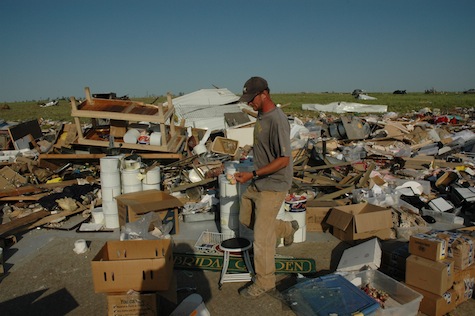Evolution Is a Movie Running Backward

Kenneth Ford, in Basic Physics (Blaisdell Publishing Co., 1968), writes:
Imagine a motion picture of any scene of ordinary life run backward. You might watch…a pair of mangled automobiles undergoing instantaneous repair as they back apart. Or a dead rabbit rising to scamper backward into the woods as a crushed bullet re-forms and flies backward into a rifle…. Or something as simple as a cup of coffee on a table gradually becoming warmer as it draws heat from its cooler surroundings. All of these backward-in-time views and a myriad more that you can quickly think of are ludicrous and impossible for one reason only: they violate the second law of thermodynamics. In the actual scene of events, entropy is increasing. In the time reversed view, entropy is decreasing.
Imagine a high school science teacher renting a video showing a tornado sweeping through a town, turning houses and cars into rubble. When she attempts to show it to her students, she accidentally runs the video backward. As Ford predicts, the students laugh and say, the video is going backwards! The teacher doesn’t want to admit her mistake, so she says: “No, the video is not really going backward. It only looks like it is because it appears that the second law is being violated. And of course entropy is decreasing in this video, but tornados derive their power from the sun, and the increase in entropy on the sun is far greater than the decrease seen on this video, so there is no conflict with the second law.”
“In fact,” the teacher continues, “meteorologists can explain everything that is happening in this video,” and she proceeds to give some long, detailed, hastily improvised scientific theories on how tornados, under the right conditions, really can create houses and cars.
At the end of the explanation, one student says, “I don’t want to argue with scientists, but wouldn’t it be a lot easier to explain if you ran the video the other way?”
Now imagine a professor describing the final project for students in his evolutionary biology class. “Here are two pictures,” he says:
One is a drawing of what the Earth must have looked like soon after it formed. The other is a picture of New York City today, with tall buildings full of intelligent humans, computers, TV sets and telephones, with libraries full of science texts and novels, and jet airplanes flying overhead. Your assignment is to explain how we got from picture one to picture two, and why this did not violate the second law of thermodynamics. You should explain that 2 or 3 billion years ago a collection of atoms formed by pure chance that was able to duplicate itself, and these complex collections of atoms were able to pass their complex structures on to their descendants generation after generation, even correcting errors. Explain how, over a very long time, the accumulation of genetic accidents resulted in greater and greater information content in the DNA of these more and more complicated collections of atoms, and how eventually something called “intelligence” allowed some of these collections of atoms to design buildings and computers and TV sets, and write encyclopedias and science texts. But be sure to point out that while none of this would have been possible in an isolated system, the Earth is an open system, and entropy can decrease in an open system as long as the decreases are compensated by increases outside the system. Energy from the sun is what made all of this possible, and while the origin and evolution of life may have resulted in some small decrease in entropy here, the increase in entropy on the sun easily compensates this tiny decrease. The sun should play a central role in your essay.
When one student turns in his essay some days later, he has written,
A few years after picture one was taken, the sun exploded into a supernova, all humans and other animals died, their bodies decayed, and their cells decomposed into simple organic and inorganic compounds. Most of the buildings collapsed immediately into rubble, those that didn’t, crumbled eventually. Most of the computers and TV sets inside were smashed into scrap metal, even those that weren’t, gradually turned into piles of rust, most of the books in the libraries burned up, the rest rotted over time, and you can see see the result in picture two.
The professor says, “You have switched the pictures!”
“I know,” says the student. “But it was so much easier to explain that way.”
Evolution is a movie running backward, that is what makes it so different from other phenomena in our universe, and why it demands a very different sort of explanation.
For a somewhat more scientific version of this story, see “A Second Look at the Second Law,” my withdrawn Applied Mathematics Letters article.
